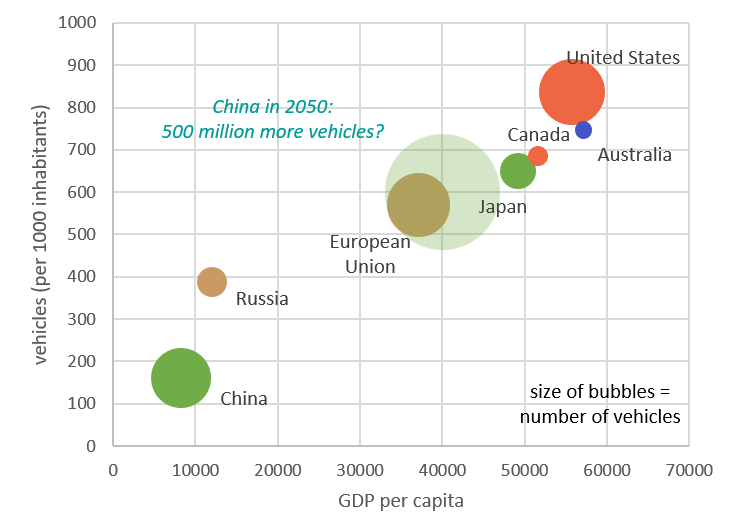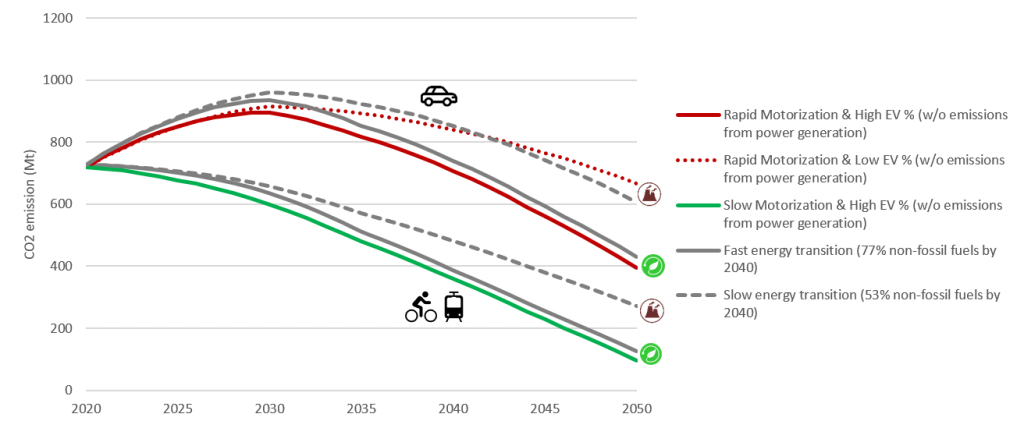The 500-million-vehicle question: What will it take for China to decarbonize transport?
2021.06.18
2ff263e1-62d1-48fb-bc9c-cad9887e2bc7.jpg)
In China, there are currently fewer than 200 vehicles per 1,000 people, compared to about 600 in the European Union and over 800 in the United States (Figure 1). If China reaches the motorization rate of the EU by 2050, there will be 500 million more vehicles, equal to the current total number of vehicles in the US and EU combined. And China is not alone. Passenger car sales in Vietnam, for example, rose over 30 percent between 2014-19; the number of vehicles in Nigeria is expected to nearly double in the next 20 years, from 35 million in 2020 to 66 million in 2040.

The motorization rate is correlated with the share of transport emissions: in China, the share of transport in overall carbon emissions is around 10 percent, whereas in Germany and the US where motorization rates are significantly higher, transport emissions account for 24 percent and 36 percent of the total, respectively. Based on this, as China’s motorization rate rises, it is expected that the share of transport in total emissions would increase accordingly, unless their fuel sources and energy efficiency significantly improve through electrification and other technological improvements.
The pace and magnitude of vehicle electrification in China will therefore have a significant impact on the trajectory of transport emissions in the country. While China has made a head-start compared to most other developing countries, EVs accounted for less than 6 percent of total vehicle sales in China in 2019, much lower than 56 percent in Norway, 23 percent in Iceland, and 15 percent in the Netherlands. Nevertheless, the market and policy makers seem optimistic about the future. The capital market is bullish on China’s EVs: new ventures that exclusively produce electric fleet—companies like NIO, XPeng and Li Auto—make up about 30 percent of total capitalization of the automotive industry in China. The China Academy of Transportation Science (CATS) projects that the share of EVs would increase from less than two percent in 2020 to over 80 percent by 2050.
The bad news, however, even with the EV market share of over 80 percent and full energy transition to renewable sources by 2050, soaring motorization rates would cause China’s transport emissions to stay much too high. Under that scenario, if China were to reach 600 vehicles per 1,000 people (the current level of the EU), as shown in the solid red line in Figure 2, transport emissions would still be about half of their current level. That is much better than the low EV market share scenario (red dotted line), but remains far from carbon neutrality, which China has pledged to reach by 2060. This suggests that relying solely on electrification is a risky strategy.

Note: High and low EV shares are 80% and 40% of total fleet by 2050, respectively; non-fossil share of 53% and 77% by 2040 come from the WRI scenarios (2020)
Source: WB staff estimates based on data from WRI, Argonne, CATS
To decarbonize transport, China needs to move beyond electrification and tackle car-dependency directly. For instance, if China’s motorization rate were to plateau at 350 vehicles per 1,000 people, assuming the same aggressive market share of EVs, transport sector emission in 2050 would be less than 15 percent of the current level (green solid line in Figure 2). Achieving net zero by 2060 suddenly becomes much more feasible. Emission reduction that can be achieved through slower motorization can be greater by multi-folds than what can be delivered by an aggressive EV market strategy alone.
In sum, electrification is necessary but not sufficient for decarbonizing transport.Comprehensive transport planning is required to help avoid unnecessary vehicle trips—for example, by bringing homes and jobs closer to one another, or by improving the integration between public transport and shared bikes. Some of these measures may even be cheaper and easier to implement than electrifying vehicles without any effort to reduce car dependency, and would bringing significant co-benefits, such as less congestion and more livable streets.
The best answer to the 500-million-vehicle question may be to avoid getting to that level of car dependency in the first place.
Author
Jung Eun “Jen” Oh
Infrastructure Sector Leader for China and Mongolia, the World Bank
Acknowledgement: This blog benefited from inputs from Yang Chen (Senior Transport Specialist, IEAT2). Mingyang Hao and Danhui Tian (Consultants, IEAT2) collected data for the analysis.




